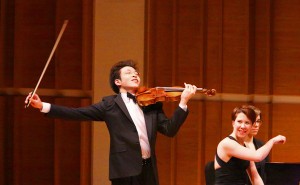Press
A Debut With a Proustian Touch.

The violinist Paul Huang’s Francophile New York recital debut on Tuesday evening at Merkin Concert Hall had an unlikely literary connection.
At one point in Proust’s “In Search of Lost Time,” Charles Swann remembers Vinteuil’s sonata for violin and piano, a work inextricable in his mind from his love for Odette.
“Below the delicate line of the violin part,” he recalls, “slender but robust, compact and commanding, he had suddenly become aware of the mass of the piano part beginning to emerge in a sort of liquid rippling of sound.”
Proust later suggested that the fictional Vinteuil’s sonata was inspired by a real work, perhaps Saint-Saëns’s Sonata No. 1 in D minor, which the author had heard in a recital and loved. The “little phrase” that Proust describes in Vinteuil’s sonata, the one that emerges over the piano’s rippling, may well be the second theme of Saint-Saëns’s first movement.
When Mr. Huang, 22, played the Saint-Saëns sonata on Tuesday with the pianist Jessica Osborne, under the auspices of the venerable Young Concert Artists series, his sound was not far from the “slender but robust, compact and commanding” tone described by Proust. He sounds like a wire filament: lithe but with a metallic bite — even, in intense moments, a satisfying squeal of vehemence.
In a program note Mr. Huang wrote that French music, which dominated the program, held particular appeal for him, and he plays that repertory with sensitivity, a range of color and a light touch. (The opener, Beethoven’s Sonata No. 8 in G, seemed out of place, a remnant of the convention that a debut recital must include a canonical Classical or early Romantic selection; there was no reason for the recital not to be entirely French.)
Mr. Huang sounded sweet and assured throughout, from his perfectly balanced, lucid double-stops in Ysaÿe’s Sonata No. 3 in D minor for solo violin to the confident mixture of cool and soulfulness in both Messiaen’s “Theme and Variations” and Ravel’s tranquil, twinkling “Pièce en forme de Habanera.”
Two works by Debussy, the smoky slow waltz “La plus que lente” and the gentle song “Beau soir,” highlighted Mr. Huang’s subtlety, his sense of how to shape the line dramatically but without exaggeration.
Even his moments of virtuosic showmanship felt earned and natural. The fantasy on themes from Bizet’s “Carmen” that Mr. Huang chose, the film composer Franz Waxman’s rather dull version, is less sparkling than, say, Sarasate’s. But when it heats up near the end, Mr. Huang was ready with finger-bending agility and more of those gorgeous double-stops.